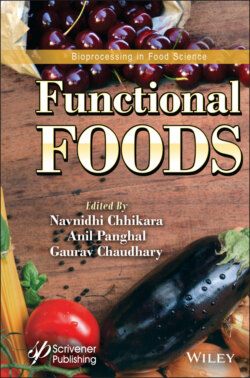Читать книгу Functional Foods - Группа авторов - Страница 20
1.4.2 Cereal Based Functional Foods
ОглавлениеCereal grains are grown all over world due to their adaptations to wide range of environmental conditions and are the staple food across the globe [22, 23]. Different cereals consumed are wheat, rice, maize, sorghum, barley, millets possess numerous macro, micronutrients and bioactive compounds accounting for numerous health benefits [24]. Different bioactive compounds present in cereals viz., tannins, phytates, phenolics, flavonoids, carotenoids, anthocyanins, phytosterols and fibers etc. have been associated with lowering cholesterol level, oxidative stress, prevent cardiovascular disease, diabetes, obesity and cancer etc. This clearly indicates about their potential for usage as functional food ingredient [25]. The fibers like β- glucan, arabinoxylans and oligosaccharides like galacto- and fructo- oligosaccharides and resistant starch stimulates and maintains the growth of intestinal microflora and also act as prebiot-ics [13]. The immature kernels of grains contain higher amount of lysine, fructans, and simple sugars and thus appropriate to be used in functional foods [26]. The extraction and purification of such biologically active ingredients can be attained by knowledge of their distribution pattern in grain and concentration at different maturity levels and advanced processing technologies. β-glucan is a valuable dietary fiber present in barley and oats, accounting for reducing the cholesterol level and glycemic index. Extracted β-glucan have been incorporated in various products like breakfast cereals, baked products, pasta, chews, nutrition bars, yoghurt, ice-cream, beverages and dietary supplements. The different industries like Cargill, Kerry Group, Angel Yeast Co. Ltd., Agroingredients Technology, Super beta glucan, Immuno medic, DSM, Ohly, Tate & Lyle PLC, Frutarom, Sigma Aldrich Corporation, Alltech Life Sciences, Parrheim Inc., Lesaffre International, Biorigin, Nutraceuticals Inc., Speciality Biotech, Ceapro Inc., and GlycaNova are the leading key player industries for beta glucan.
Resistant starch is defined as starch which is resistant to digestion in small intestine and passes to the large intestine and is fermented by intestinal colon microflora. Resistant starch fermentation produces short chain fatty acids, acetates, propionates and butyrates [27]. Resistant starch can be incorporated in wide range of food due to their water solubility and indigestibility without any impact on sensory profile of food. This will provide bulk to food sample without contributing calories. The prolonged consumption of resistant starch may decline the fasting cholesterol and triglycerides and increases the absorption of micronutrients [28]. Lopez et al., [29] reported the improved absorption of minerals (calcium, magnesium, iron, zinc and copper) in intestines of rats when fed on a resistant starch rich diet.
Oilseeds are a rich source of proteins, fiber, fat, minerals, vitamins and bioactive compounds such as flavonoids, tocopherols, phenolics, lignans, tocotrienols, peptides and thus considered as suitable functional ingredient [30–32]. This rich phytochemical profile accounts for high antioxidant activity and also accounts for reducing the oxidative stress and cancer also. Oilseed fat is rich in n-3 and n-6 fatty acids polyunsaturated fats (PUFA) with higher concentration of linoleic acid and decline the risk of inflammation, cardiovascular disease, blood pressure, rheumatoid arthritis, sclerosis and cancer etc. [33]. The hydrolysis of sesame hydrolysate with pepsin, papain and alcalse produced the peptides with enhanced digestibility, antihypertensive characteristics and antioxidant profile [34].
